What is the diet for hypothyroidism?
They call a disease of the thyroid gland, in which the production of hormones is disrupted, as a result of which all systemic processes in the human body are disrupted. Deceleration of metabolism, including disruption of the production of digestive tract enzymes, tissue hypoxia and a decrease in energy expenditure, leads to fatigue, edema, hypotension and contributes to the development of atherosclerosis.
Diet is one of the principles of treatment of patients with hypothyroidism.
The basic rules of the diet for hypothyroidism
The goals pursued by clinical nutrition in this disease are:
- normalization of metabolic processes;
- preventing the development of atherosclerosis;
- restoration of blood supply to tissues;
- weight loss.
According to Pevzner's classification, this diet corresponds to the treatment table No. 10c.
Therapeutic nutrition for hypothyroidism implies some restriction of fats (mainly animals) and carbohydrates (due to simple ones).
- proteins - 80g, of which 50-55% are vegetable proteins;
- fats - 70-80g, of which 35% are vegetable fats;
- carbohydrates - 350-400g, and sugar - no more than 50g.
The energy value of the daily diet is 2200-2400 kilocalories.
Basic Rules:
- diet;
Food is consumed fractionally: up to 5-6 times a day in small portions. Compliance with the principle of fragmentation allows the gastrointestinal tract to better break down nutrients and absorb minerals and vitamins. - culinary processing;
With hypothyroidism, cooking, steaming, baking is allowed. Products should be crushed, which contributes to the mechanical sparing of the digestive tract. Frying is excluded, since during this process, fat breakdown products are formed that adversely affect blood vessels and all metabolic processes. - food temperature;
Food should be served warm (15-60 degrees Celsius). Foods that are too cold or hot are annoying gastrointestinal tract, and the body, weakened by hypothyroidism, spends a lot of energy on their digestion. - drinking regimen and salt;
The amount of free fluid is limited to 1-1.5 liters per day: with hypothyroidism, edema occurs, which, even without excess fluid, disrupt metabolic processes in tissues. Salt is limited to 5-6 grams per day, which provides chemical sparing of the stomach and does not contribute to fluid retention in the body. Patients with hypothyroidism are advised to eat iodized salt as iodine is necessary for the production of thyroid hormones. - alcohol;
The use of alcohol is prohibited in all therapeutic diets, and especially in case of hypothyroidism. Ethyl alcohol slows down metabolic processes and irritates the digestive tract. - vitamins;
Nutrition for hypothyroidism should be enriched with vitamins. It is important to saturate the body with ascorbic acid: it strengthens the vascular wall, thus preventing the occurrence of edema and the development of atherosclerosis. In the body, there is a slowdown in metabolic processes caused by a lack of thyroid hormones, so the metabolism needs stimulation, which vitamins can provide. In addition, some vitamins are involved in the functioning of the thyroid gland. Therefore, the diet should contain a lot of vegetable fiber: it not only contains a large amount of useful substances, but also normalizes intestinal motility.
Approved Products
The list of allowed products, first of all, should include those that contain vegetable and animal protein: it is necessary for all metabolic processes, cell building and hormone synthesis. Especially welcome foods rich in tyrosine.
Must be included in the diet and meals, in in large numbers containing iodine: it is involved in the production of thyroid hormones. B vitamins should be present in the daily diet: they also take part in the production of hormones, vitamin C: it strengthens the vascular walls, linoleic acid and lipotropic substances: they help to remove “bad” cholesterol from the body.
In addition, therapeutic nutrition for hypothyroidism should moderately stimulate the gastrointestinal tract, without causing its overload and without provoking gas formation, therefore, the introduction of dishes rich in vegetable fiber and fermented milk products into the diet is indicated.
- bread from flour of 1 and 2 grades, yesterday or dried, dry biscuits;
- lean meats, "white" chicken meat containing tyrosine;
- low-fat varieties of sausages;
- fish, mainly marine (cod, mackerel, salmon), rich in phosphorus, polyunsaturated fatty acids and iodine;
- low-fat milk and lactic acid drinks, as well as cottage cheese, sour cream - in dishes;
- cheese of unsalted, low-fat and non-sharp varieties;
- protein omelettes, soft-boiled eggs, yolk with care;
- cereals (buckwheat, millet, barley), casseroles and dishes from them;
- fresh vegetable salads seasoned with vegetable oil, vinaigrette, aspic;
- any fruit, especially persimmon, feijoa, kiwi, which are rich in iodine, as well as cherries, grapes, bananas, avocados;
- vegetables, with the exception of the cruciferous family, fresh herbs;
- horseradish and mayonnaise with care;
- weakly brewed drinks (coffee and tea), tea with lemon or milk, freshly squeezed juices, decoctions of rose hips and bran;
- butter with caution, vegetable oils - in dishes and when cooking;
- seafood (mussels, scallops, oysters, sea kale, rolls and sushi from them).
Prohibited Products
Among the prohibited foods, those containing soy can be especially distinguished, since the isoflavones contained in it suppress the activity of the thyroid gland.
Cruciferous vegetables should be excluded from the diet, since the isothiocyanates that are part of them disrupt the thyroid gland.
Unfiltered tap water is rich in chlorides, which negatively affect iodine receptors in the thyroid gland, and should also be avoided.
In addition, extractive substances, foods rich in animal fats (liver) and cholesterol, which disrupt the absorption of nutrients, vitamins and minerals, and contribute to the development of atherosclerosis, are excluded.
Easily digestible carbohydrates are also prohibited: they are easily broken down in the intestines, disrupt digestion and increase the level of "bad" cholesterol. Products that promote gas formation are contraindicated in hypothyroidism: it causes rotting of food masses, disrupts the absorption of nutrients.
The list of prohibited products includes:
- bread from flour of the highest grade, all pastries, cakes, pastries, fried products (patties, pancakes, pancakes);
- fatty meats (pork, lamb) and poultry (goose, duck);
- liver (brains, liver, kidneys);
- fish caviar;
- smoked and salted fish, canned fish;
- fatty varieties of sausages;
- margarine, lard, cooking oil;
- all legumes;
- cruciferous (all types of cabbage, turnip, radish, radish, turnip);
- mushrooms in any form;
- rich broths from meat, poultry and fish;
- jam, honey are limited;
- mustard, pepper, horseradish;
- strong tea or coffee, cocoa, Coca-Cola;
- smoked meats, pickles;
- pasta and rice limited.
The need for a diet
Dieting will certainly not get rid of hypothyroidism, but it will alleviate many of its symptoms, such as irritability, lethargy, drowsiness, and a tendency to edema.
Therapeutic nutrition in case of illness will help prevent the development of atherosclerosis, and also improve appearance patient (skin, hair, nails).
With obesity, the diet contributes to the normalization of weight, optimizes the work of the gastrointestinal tract, prevents the development of constipation and bloating.
Consequences of not following the diet
If the diet is not followed, hypothyroidism can not only cause atherosclerosis, but also provoke the development of such a terrible complication as myxedematous coma.
If a child suffers from hypothyroidism, then the lack of treatment, coupled with non-compliance with the diet, will negatively affect his mental development (oligophrenia or cretinism).
If a pregnant woman with hypothyroidism neglects the diet, there is a high probability of having a child with gross malformations and impaired thyroid function.
Hypothyroidism is an unpleasant disease of the thyroid gland, which is characterized by an insufficient amount of hormones produced and, as a result, a slowdown in metabolism, weight gain, inhibition of mental processes, and much more. This disease is rarely detected at an early stage, and treatment is usually rather difficult. To relieve symptoms and return to a normal life, you can use a diet for hypothyroidism, which will allow you to feel better in a matter of weeks. Consider its basic principles.
Therapeutic nutrition for hypothyroidism: a list of prohibitions
Hypothyroidism requires a diet that does not interfere with the production of hormones. It is believed that there is a group of antithyroid products that stimulate the production of estrogen and inhibit other hormones. So far, this opinion has not received official confirmation, but just in case, it is better to exclude the following foods from the diet for hypothyroidism:
- soy and soy products;
- sugar;
- polyunsaturated fats (omega-3 and omega-6 found in fish oil, sunflower seeds, vegetable oils, almonds, peanuts, avocados).
If everything is clear about soy and sugar, then polyunsaturated fats cause controversy, because for an ordinary person they are indispensable and very important. However, the diet offers its own alternative to this.
Proper nutrition with hypothyroidism is based on a few simple principles, following which you can greatly alleviate the symptoms of diseases, and possibly even get rid of them over time. By the way, it is worth noting that official medicine usually does not prescribe a special diet in this case, but such measures are fully justified. So, what should be included in the diet for hypothyroidism?

Hypothyroidism requires limited nutrition, even in such an important element as water. It is recommended to use it in total with tea and soups up to 1.5 liters per day, so as not to provoke edema and other troubles.
The most important thing to recognize is that hypothyroidism is a serious enough disease to initially refuse self-medication. You should not take any drugs or supplements on your own, for example, the same iodine, since this disease is not always caused by its deficiency, and an excess of any substance in the body gives an unpleasant effect.
womanadvice.ru
nutrition for hypothyroidism
With hypothyroidism of the thyroid gland, all types of metabolism are disturbed, the formation of certain vitamins is “turned off”. For example, vitamin A.!!! In this case, it is useless to replace the finished preparation of vitamin A with carrots and any forms of carotene. It is no coincidence that the picture of hypothyroidism is so "visible", because without vitamin A, skin, nails, hair, our eyesight suffer first of all ... It is important for patients to establish a reasonable diet for hypothyroidism: eat less sugar, do not get carried away with fatty and high-calorie foods. Preferably vegetable, one that stimulates the activity of the intestines. Never hurt the massage of the abdomen, moderate motor mode. As the disease is compensated, the load can be increased.
Diet therapy plays a supporting role. The energy value of the diet is limited by 10–20% compared to the physiological norm due to fats and carbohydrates. To correct impaired lipid metabolism and hypercholesterolemia in the diet, foods rich in cholesterol and saturated fatty acids are limited: fatty meat and dairy products, margarines. Limit easily digestible carbohydrates: sugar, honey, jam, confectionery. The diet includes foods and dishes that moderately stimulate gastric secretion, and also have a laxative effect: vegetables, fruits, berries, dried fruits, juices, vegetable oils, fermented milk drinks, products with bran.
With medical correction of hypothyroidism, it is recommended to limit the consumption of cruciferous vegetables, and also not to combine the drug with the use of soy products, which can suppress the absorption of thyroid hormones from the intestines.
How to eat with thyroid disease?
Proper nutrition does not imply strict restrictions. Replacing some products with others should take place smoothly, gradually adjusting the body to a new diet:
- refuse sweet foods, soda, alcohol, cigarettes, canned food, salt, spices, vinegar, coffee and ice cream;
- replace meat with fish (although 2-3 times a week);
- focus on living food (that is, raw foods);
- sweets are replaced with dried fruits;
- arrange fasting days on fruits and vegetables;
- we allow the body to break the diet, at least once a week to eat delicious food.
1. In the first place are seafood (squid, cod liver, sea fish), sea kale.
2. In second place are vegetables and fruits (persimmon, feijoa, dates, chokeberries and currants, prunes, apples, cherries, cucumbers, potatoes, beets, carrots, cabbage, eggplant, garlic, radish, lettuce, spinach, tomatoes, onions ).
3. On the third - cereals (buckwheat and millet).
4. On the fourth - protein products (meat, milk, cheese, cottage cheese, egg yolk).
To eat rationally and for health, you need to follow certain rules:
- do not eat without a feeling of hunger;
- do not pass and chew food well;
- eat different foods every day;
- do not eat too hot or too cold food;
- after eating, do not engage in mental or physical work, since the energy goes to the digestion of food.
To preserve iodine in food during cooking, you must:
- keep vegetables and fruits in a dry, dark, cool place;
- steam vegetables in a covered container;
- do not bring dishes to a boil, because meat loses 50% of iodine, vegetables - up to 30%, and milk - up to 25%;
- use iodized salt for dressing ready meals.
What can not be eaten with thyroid disease?
In diseases of the thyroid gland, it is necessary to refuse food that takes away the energy of the body, and does not saturate it:
1. Refined sugar products - sweets, marmalade, cakes, cakes, juices with sugar.
2. A variety of seasonings, sauces and marinades.
3. Salty foods and salt.
4. Refined products (white rice, corn flakes, white flour and products made from it).
5. Trans fats (soft margarines).
6. Coffee, tea and alcohol - as stimulants of the nervous system.
7. Fatty pork and smoked meats.
8. Meat products with chemicals (sausages, sausages - nitrates, dried meat).
9. Any canned food (canned food, stew, soups) --- CORN GRINS REDUCES THE TRANSITION OF T4 TO T3
HOW TO LOSE WEIGHT WITH HYPOTHYROISIS?
When you were diagnosed with hypothyroidism, the doctor said reassuringly - it's okay, you will take hormones and your weight will return to normal on its own or with the help of an easy diet. However, time passed, diets became more and more rigid, you played sports more and more - but your weight did not even think to fall. The endocrinologist shrugged his shoulders and said that the thyroid gland has nothing to do with it, your hormonal imbalance is compensated and nothing can stop you from losing weight calmly. You turned to different doctors, asked for advice on the forums - but the answer was always the same - “hypothyroidism has nothing to do with it, eat less, move more!” But you saw - something is wrong ...
Familiar situation? Mary Chaumont, author of the American bestseller The Hypothyroid Diet, claims that most hypothyroid patients have experienced it in one way or another. Mary, your “colleague” in illness, has spent a great deal of time and effort trying to understand the situation and has come to the conclusion that metabolic disorders in hypothyroidism are not limited to a simple lack of thyroxine. Therefore, in order to lose weight, the patient does not have enough of the methods used by healthy people. She notes a number of points that you need to consider in your fight against excess weight.
Make sure your TSH is low enough
Most physicians prefer to limit thyroxine administration as soon as TSH returns to normal. This norm is quite wide - from about 0.5 to 5.0 mU / l. Accordingly, when your TSH drops below 5.0 mU/L, your doctor decides to keep the amount of T4 taken at this level. However, new guidelines from the US National Academy of Clinical Biochemistry suggest that 2.5 mU/L should be considered a normal upper limit. Furthermore, clinical practice many endocrinologists shows that for patients with hypothyroidism, optimal well-being is achieved at a TSH level of about 1.0 mU / l. That is, high normal values are good for healthy person, but are not suitable for a patient using hormone replacement therapy.
Are you taking anything that interacts with L-thyroxine medications?
The effectiveness of the taken L-thyroxine may decrease depending on what you eat and take in addition. Calcium preparations (including calcium in vitamins), the use of soy products, as well as estrogens (contained in birth control pills) can give a negative effect.
Are you eating enough to lose weight?
"Hungry" diets are categorically contraindicated in hypothyroidism. Metabolism, which is already not in the best condition, can slow down greatly at caloric content below 1200 kcal. The calorie deficit in your daily menu should be about 500 kcal, no more. Mary Chaumont offers this calculation of the calorie content of your diet - multiply the weight in kilograms by 25 and subtract 200 kcal. Perhaps, after the amount of food that you have been accustomed to eating in recent years, such a value will seem huge to you. However, it is necessary. Eat more often, in small portions - the level of basic metabolism increases after each meal.
insulin resistance
Insulin resistance is a state of the body in which an increase in the amount of insulin in the blood does not lead to better absorption of sugar. Your body cannot process carbohydrates properly, and instead of using sugar for energy, your body stores fat. You are hungry... and getting fat. In addition, insulin resistance leads to high blood pressure, chronic fatigue, increased irritability and increases the risk of developing diabetes and atherosclerosis. It also impairs the breakdown of fats in the body, which further prevents you from losing weight.
Insulin resistance is a frequent companion of hypothyroidism. Clinical markers of insulin resistance are the abdominal type of obesity (the waist-to-hip ratio is more than 0.8 for women and 1.0 for men), as well as acanthosis nigricans, which is often found in this disease - wrinkled, hyperpigmented areas of the skin, most often under the armpits, on elbows, knees.
How to deal with this unpleasant condition? The most effective way to reduce insulin resistance is to reduce body weight. Here is such a vicious circle. The dietary advice for insulin resistance is that you should limit the amount of fat you eat and, last but not least, the amount of simple carbohydrates found in sugar, white flour, sweet fruits, potatoes, and so on. Many of the recently popular low-fat diets, in which the desired calorie content is achieved by increasing the amount of carbohydrates, are categorically not suitable for you. Eat vegetables, legumes (but not soy, mind you!), lean meats - turkey, chicken, veal ... in general, the recommendations are pretty standard. An almost instantaneous result of such a diet will be an improvement in well-being - reduced fatigue, normalization of sleep, you will no longer feel "broken". Well, in the future, of course, the weight will also decrease.
The second important factor in the fight against excess weight is physical activity. Recommended long-term aerobic exercise - walking, swimming, exercise bike. A daily hour-long walk can improve insulin sensitivity by 40%!
There are also pharmaceutical drugs that increase insulin sensitivity. You can consult your endocrinologist about taking any of them.
Appetite
Another consequence of hypothyroidism is the inconsistency of brain reactions with the level of metabolism.
Since the patient's metabolism is slowed down, the brain gives the command about the lack of the substances it needs too late. You end up eating more than your body actually needs. Another obstacle on the part of the brain is that your body constantly experiences the so-called “physiological stress”. Because of this, the level of serotonin decreases and this also prevents you from losing weight. The tools of struggle here are the already mentioned aerobic exercise, as well as the intake of sedative drugs. It is not necessary to take powerful antidepressants, herbal preparations are enough - for example, St. John's wort (or St. John's wort Deprim).
We hope that this information will be useful to you in your difficult struggle with excess weight, and you will succeed.
Good luck on this path!
Z.s. Girls, I myself am on thyroxine 100 mg, so I know firsthand how difficult it is to deal with excess weight and hypothyroidism in such a situation. Never give up! Everything will work out!
Well, the New Year's me for you last! Happy New Year everyone!!

baby.ru
Diet for the thyroid

The thyroid diet provides proper body homeostasis
A diet for the thyroid gland is an integral part of the treatment and prevention of diseases of this organ and contributes to a significant improvement in the condition of patients.
The thyroid gland plays a very important role for the human body, because the failure of its work can adversely affect the functioning of other organs. Its main function is the synthesis of a number of hormones that maintain the correct homeostasis of the body.
Causes, symptoms and dietary habits in thyroid diseases
Today, thyroid diseases are very common throughout the world. Most often, their occurrence contributes to a genetic predisposition. But, besides this, there are also many external factors related to the development of thyroid pathologies. These include:
- frequent stress;
- malnutrition leading to iodine deficiency;
- environmental situation in the world elevated level radiation;
- various infectious and chronic diseases;
- the use of certain medications.
- Hypothyroidism is a condition in which the level of hormones decreases, which causes damage to some organs, a slowdown in metabolic processes. The symptoms of this disease are: fatigue and a feeling of weakness, lack of desire to work, memory impairment, and the appearance of edema. In addition, the hypofunction of the thyroid gland is evidenced by the deterioration of the hair, skin, rapid weight gain.
- The opposite of hypothyroidism is thyrotoxicosis, during which the level of thyroid hormones is too high, therefore, metabolic processes are accelerated. The most common symptoms of hyperthyroidism are constant irritability of the patient, irascibility for unknown reasons, insomnia, and rapid pulse. In addition, the development of the disease is indicated by rapid weight loss when eating large amounts of food, sweating and heat body.
Diseases of the thyroid gland are extremely dangerous for the whole body, because without timely treatment, other vital organs can also be affected. An oversized thyroid gland affects the larynx, vocal cords, and hyperfunction can cause tachycardia.
Drafting a complete diet in diseases of the thyroid gland is the key to successful treatment and recovery. Dietary nutrition, together with medical procedures, will ensure the constant functioning of this organ, maintain optimal body weight, and strengthen the heart. In addition, proper nutrition normalizes metabolic processes and will lead to the resumption of hormonal stability.
In the treatment of thyroid diseases, it is necessary, first of all, to completely exclude sweets, carbonated drinks, canned, salty, spicy foods, coffee and, of course, alcohol from the menu. Preference should be given to sea fish, dried fruits and vegetables.
For the healthy functioning of the thyroid gland, it is necessary to increase the intake of iodine in the body, namely, to eat more seafood and seaweed, eggs, meat and other foods rich in protein, cereals, vegetables and fruits. To help his health, the sick person should also drink enough clean water.
Prohibited products include:
- sausage, sausages, smoked meats, pickles, canned food;
- strong tea, coffee and alcoholic drinks;
- white rice, bread and other refined foods;
- pure sugar and other sweets.
You should be wary of not only a lack, but also an excess of iodine, so before starting a diet or using chemical supplements, you need to consult with your doctor.
Diet for hypothyroidism and other thyroid diseases: sample menu and features
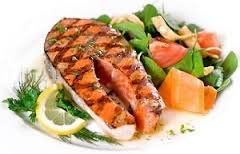
Diet for hypothyroidism
In case of insufficient thyroid function (hypothyroidism), patients are prescribed a low-calorie diet, it is recommended to reduce the amount of fats and carbohydrates consumed, and completely eliminate all foods high in cholesterol, salt, which causes swelling.
People with this disease should limit their intake of foods containing vitamin A, namely apricot, carrot, liver, pumpkin, etc. It is impossible to completely exclude such food from the diet, it is enough just not to abuse it.
The diet for hypothyroidism of the thyroid gland provides for an increase in the amount of protein consumed, dairy products, various cereals, vegetables and fruits. It is recommended to eat at least 5 times a day to stimulate the synthesis of hormones in the thyroid gland.
The energy value of the daily diet should not exceed 2100 kcal. An example menu looks like this:
- Breakfast: a small portion of buckwheat with meatballs, a cup of weak tea.
- Snack: cottage cheese and a glass of unsweetened prunes compote.
- Lunch: carrot soup, mashed potatoes with boiled meat, fruit compote.
- Snack: lean meatballs, tea.
- Dinner: light salad, scrambled eggs without yolk, compote.
- Snack before bedtime: jelly.
Diet for hyperthyroidism
The diet for hyperthyroidism (thyrotoxicosis) is aimed at consuming more calcium, which reduces the production of thyroid hormones. Due to increased excitability during illness, it is not recommended to consume foods that excite the central nervous system: spicy, chocolate, coffee and tea.
Menu for increased thyroid function:
- Breakfast: salad with cabbage, apples and sour cream, scrambled eggs with cheese, oatmeal boiled in milk, weak tea.
- Snack: toast with a slice of cheese, tomato juice.
- Lunch: borsch, cooked on the basis of meat broth, brown rice, boiled chicken meat, compote.
- Snack: biscuit cookies, rosehip broth.
- Dinner: carrot puree, meatballs, cottage cheese casserole, tea.
- Snack: a glass of kefir.
Diet after thyroidectomy
The diet after the removal of the thyroid gland does not strictly limit the intake of any products. It's important to lead healthy lifestyle life and adhere to the principles rational nutrition. It is necessary to give up alcohol, soda, limit the consumption of sweet, fatty and smoked.
The use of soy products should be reported to the doctor, as soy interferes with the absorption of the hormone. Fasting and low-calorie diets after thyroidectomy are strictly prohibited.
Diet for thyroid cancer
In conjunction with the course of treatment, as a rule, a diet is also prescribed for thyroid cancer. Its peculiarity is that the diet of such a dietary program is depleted in iodine. The nutrition of people suffering from this disease must necessarily be balanced.
The following foods are excluded from the diet:
- seafood,
- iodized salt,
- dairy,
- eggs,
- chocolate,
- beans.
The consumption of fresh meat, rice, cereals and cereals is limited.
Results, recommendations and reviews of doctors on therapeutic nutrition for thyroid diseases
Reviews of doctors about the diet for the thyroid gland are positive, especially if it is chosen by the doctor, taking into account the exact diagnosis and condition of the patient.
The results of the diet for the thyroid gland are noticeable after a few days of its use: mood improves, sexual desire increases, irritability disappears.
A properly selected diet helps the thyroid gland to work without interruption, maintains the normal weight of the patient, and strengthens the heart.
happy-women.com
Diet for hypothyroidism: menus and recipes | Competently about health on iLive
A diet for hypothyroidism is a set of rules aimed at restoring the functioning of the thyroid gland, which should be followed. Consider the features of therapeutic nutrition, delicious recipes and helpful menu.
Hypothyroidism is a disease of the thyroid gland in which the production of thyroid hormones is disrupted. There are many reasons for the malfunction of the body. Most often it is a failure of the hormonal background, heredity or the influence of harmful factors. Symptoms of the disease are different, primarily fatigue, lack of energy, drowsiness, cold intolerance, constipation, painful menstruation and weight gain (even in the absence of appetite). These signs may go unnoticed or be associated with a number of other causes, such as stress, depression or overwork.
As the disease progresses, the symptoms begin to increase. In most patients, the pulse may slow down, the skin becomes cold, dry and begins to coarsen, there is pain in the muscles, swelling around the eyes, and the face becomes pasty. Hair begins to fall out on the head, eyebrows, intimate areas. The voice becomes hoarse and a little rough, and the reflexes are sluggish.
Treating hypothyroidism with diet
Treatment of hypothyroidism with a diet is one of the methods of treating this disease. It is carried out along with drug treatment, and then as a method of prevention and correction.
On the early stages disease is treated with diet. The endocrinologist conducts a comprehensive examination and selects a diet suitable for the patient. The therapeutic diet is necessary to restore a weakened body and depends on the form and type of hypothyroidism. With its help, you can eliminate the causes that caused the disorder.
When choosing a diet, the endocrinologist discusses all nutritional issues with the patient, clarifying and explaining its purpose and importance. And also finds out what result the patient expects. For example, there are nutritional recommendations aimed at weight loss, since one of the symptoms of the disease is weight gain. In addition, the doctor tries to take into account the material possibilities of the patient.
Nutrition for hypothyroidism
Nutrition in hypothyroidism plays an important role, since very often patients do not think that food and its proper preparation are the key to a healthy and strong body. In our modern society, it is increasingly possible to meet patients with this disease. And every year the age of the disease is getting younger. Previously, the disorder was diagnosed in menopausal women, but now it occurs in 20-30 year olds.
The patient needs to correctly compose his menu, that is, a therapeutic and restorative diet. Products must be fresh and contain useful vitamins and minerals, as the disease disrupts many body functions. The deficiency of nutrients can be restored with medication, combining drugs with food during and after treatment. Products must be properly processed during cooking in order to retain all the beneficial properties. For these purposes, modern kitchen devices that are indispensable in the kitchen are perfect.
What can you eat with hypothyroidism?
What you can eat with hypothyroidism - nutritionists recommend taking diet table No. 15 and No. 8 as the basis of their menu. The menu has a lot of tasty and healthy dishes that contain all the necessary vitamins and minerals. Often, the disorder leads to violations of the production of vitamin A, therefore, foods with this ingredient should be in the diet. There is a lot of "pure" vitamin A in the liver, especially in cod liver (pork and beef are also suitable) and carrots. Useful and marine products containing iodine, zinc, calcium, phosphorus.
Hypothyroidism increases the risk of developing osteoporosis. Therefore, patients need to get enough calcium and phosphorus, which is necessary for the absorption of vitamin D. When choosing and compiling a diet, one should not forget that there is a lot of calcium and phosphorus in dairy products, especially in cheese, legumes, fish, fresh vegetables and fruits. There is a lot of vitamin D in fish, especially fish liver and caviar, butter, and eggs.
In addition to food, medicinal properties enjoy outdoor walks. They help keep the body in good shape, cheer up, eliminate depression and poor health.
What can not be eaten with hypothyroidism?
What not to eat with hypothyroidism - nutritionists recommend refraining from a quick snack. Fast food, fatty, spicy, fried, sweet and starchy foods are banned. Many unhealthy foods contain soy and trans fats. These substances are poorly absorbed and excreted from the body, disrupt the absorption of minerals and vitamins.
After eating such food, there is a rapid satiety, but then the body requires even more food. When the thyroid gland is damaged, metabolic processes slow down, so alcoholic beverages are banned. They are slowly excreted from the body and retain water, causing swelling. It is not recommended to eat fatty meat and fish, white flour products, sugar, honey, sweets.
What is the diet for hypothyroidism?
What kind of diet for hypothyroidism - this issue should be resolved only with an endocrinologist-nutritionist. If you notice the first signs of illness in yourself, you need to apply for medical care. The local therapist will listen to all your complaints and give directions for a TSH blood test ( thyroid-stimulating hormone). If the indicators are too high, then the therapist refers to the endocrinologist. The endocrinologist collects an anamnesis and, if necessary, prescribes additional tests. All this is necessary in order to adequately assign drug treatment and choose an effective diet.
Most often, patients are prescribed: the Mary Chaumont diet (helps to normalize weight), dietary table No. 8, a diet for autoimmune and subclinical hypothyroidism, and preventive nutrition to restore and maintain the body. This is one of the most effective diets. Such treatment is aimed at safely restoring the functioning of the affected organ.
Mary Chaumont's diet for hypothyroidism
Mary Chaumont's Hypothyroidism Diet was compiled by an American writer who wrote a best-selling book, The Hypothyroidism Diet. The author claims that, one way or another, the majority of patients encountered a diet. Mary herself faced thyroid disease. She spent a lot of time and effort trying to figure everything out, and came to the conclusion that metabolic disorders are not limited to a simple lack of thyroxine. Therefore, to get rid of excess weight, the methods used by healthy people are not enough.
She highlights a number of nuances to which special attention should be paid. First of all, you need to make sure that, after testing, the TSH is low enough. This is due to the fact that many physicians prefer to limit thyroxine administration as soon as the TSH level returns to normal. The norm of TSH is from 0.5 to 5.0 mU / l. Accordingly, when your TSH falls below 5.0 mU / L, the doctor decides to leave the amount of T4 taken at this level.
The author of the diet offers such a calculation of the calorie content of food - the patient's weight in kilograms multiplied by 25 and subtract 200 kcal. This will daily dose calories. Based on these calculations, you can create a menu and choose products without exceeding the recommended calorie content. You need to eat in small portions, several times a day. So you will quickly be satiated and not feel hungry. Your stomach and you will receive the necessary food, and with it vitamins and trace elements. Gradually, immunity and the hormonal system will begin to recover.
Diet number 8 for hypothyroidism
Diet number 8 is prescribed by a doctor to restore metabolic processes in the body. Therapeutic nutrition allows you to achieve the normalization of weight and restore the normal functioning of the body. With the help of a diet, doctors try to limit the calorie content of the diet. The body is stressed, which contributes to weight loss, by getting rid of excess fat from the body's reserves. Carbohydrates are reduced by a sharp restriction of bakery products and simple carbohydrates.
Foods that stimulate the production of gastric juice are removed from the diet. You need to eat several times a day, 5-6 doses will be enough. Fasting during treatment is prohibited. Useful properties raw vegetables and fruits have, in addition, they are low in calories. It is necessary to avoid the feeling of hunger, as very often it pushes you to break the diet. Products can be boiled, stewed, baked.
Restrictions also apply to liquids, you need to drink no more than 1.5 liters of purified water per day. Since metabolic functions are disturbed in the body, water is retained in the tissues, forming edema. It is recommended to reduce portions of first courses and refuse salt. Alcoholic drinks and seasonings that stimulate appetite are excluded from the menu. Once every 7-10 days, fasting days can be spent on fresh fruits and juices.
Diet for autoimmune hypothyroidism
The diet for autoimmune hypothyroidism is aimed at restoring the body. The disease is a lesion of the thyroid gland, when the body begins to produce antibodies to its own organ. That is, the body rejects the cells of the thyroid gland, destroying it. The causes of the disorder are not fully understood. Many doctors believe that the disease is the result of autoimmune processes, but it can be radiation exposure or an oversaturation of the body with iodine.
It is necessary to treat autoimmune hypothyroidism in a complex way, both with medication and with the help of nutrition. The diet provides for the rejection of fried, smoked, spicy, canned foods, as well as sweets and bakery products. It will not be superfluous to reduce the amount of fluid consumed due to the risk of edema.
Diet for subclinical hypothyroidism
The diet for subclinical hypothyroidism is a healthy diet. The disease proceeds without pronounced symptoms and is most often detected during laboratory research. If, after passing the tests, the level of TSH is increased, and the level of T4 is normal, then this indicates this type of thyroid lesion. If necessary, assign drug therapy. But most often the doctor suggests diet therapy and vitamin therapy. Vitamins are needed to restore the immune system and other body systems.
The diet is based on the use of fresh vegetables and fruits. The diet should contain non-fatty meats and seafood (chicken, rabbit, turkey, shrimp, mussels). Seafood is very important, as they are a natural source of iodine, which restores the thyroid gland. Foods containing cocoa beans and coffee will be useful, as they are rich in B vitamins and magnesium. The diet should be divided into several meals, limit your drinking to 700 - 1500 ml per day.
Diet for hypothyroidism for weight loss
A diet for weight loss with hypothyroidism is aimed at normalizing metabolic processes in the body. It is because of metabolic disorders that patients gain excess weight. Consider the basic recommendations for a healthy diet:
- It is necessary to eat often and fractionally, that is, in small portions.
- Do not starve, as this aggravates an already slow metabolism and can cause a depressive state.
- The diet should contain a lot of fresh vegetables, fruits and greens, as they contain vitamins and trace elements that are useful for restoring the body.
- Regular physical activity and walks in the fresh air.
- The diet should contain iodine-containing foods: seaweed, shrimp, mussels, squid, shellfish.
- It is necessary to abandon products that contribute to the accumulation of excess weight (alcohol, sweets, pastries, salinity).
- Limit fluid intake, as excess water in the body leads to swelling.
Diet menu for hypothyroidism
The diet menu should be varied. It is a mistake to think that a diet is tasteless food. This is far from the case, medical, healthier food is the basis of recovery. Do not forget that a lot depends on the method of cooking and, of course, the mood for recovery. Consider a sample menu for the day:
- A glass of yogurt, kefir or green tea without sugar.
- 2 boiled eggs or 1 green apple.
- Vegetable broth or light chicken soup.
- Porridge (buckwheat, barley, barley).
- Sea salad (mixed seaweed salad).
ilive.com.ua
Diet for hypothyroidism or how to eat right with this disease
It is important to eat right with this disease
Hypothyroidism is a severe endocrine disease characterized by a decrease in the production of thyroid hormones (triiodothyronine T3 and thyroxine T4) by the thyroid gland. These hormones perform many different and vital functions: they increase mental and physical activity, break down fats and prevent their deposition in tissues, accelerate and improve metabolic processes in the body, and regulate the work of the heart and blood vessels.
With their lack or complete absence, all metabolic processes in the body slow down, fat is deposited on the walls of blood vessels and during internal organs; therefore, in addition to timely diagnosis and high-quality full-fledged treatment, it is very important to observe proper nutrition in case of hypothyroidism and limit products harmful to hypothyroidism.
Power feature
As mentioned above, one of the main problems with hypothyroidism is a slowdown in metabolism, and, as a result, obesity. Naturally, medications in this case improve the situation: the patient, under the supervision of a doctor, takes thyroid hormones and thereby compensates for the current situation. However, this problem cannot be completely solved with the help of drugs, therefore, adequate dietary nutrition is extremely important for hypothyroidism:
- A minimum of fats and easily fermentable carbohydrates.
- Maximum plant fiber and protein.
- Vitamins and microelements.
Easily fermentable carbohydrates are the main enemies of patients with this pathology; This is something that in no case can not be eaten with hypothyroidism. They are very quickly broken down by the enzymes of the body, do not carry any energy value, but have a very high calorie content, so they are quickly deposited in the form of fat and cholesterol plaques. And since metabolic processes are already very slow in hypothyroidism, the abuse of such products will simply aggravate the existing situation, accelerate the development of obesity and lead to numerous complications.
With hypothyroidism, it is important to follow a diet
Fiber is very useful in case of hypothyroidism: it stimulates the gastrointestinal tract, prevents congestion in the intestines and stomach, and in addition creates a long-lasting feeling of satiety with minimal calories.
As for protein food, it, like fiber, is one of the main components of the diet for hypothyroidism: proteins speed up metabolism and prevent the accumulation of fats in the body.
In addition to the main components of food, it is very important for hypothyroidism to consume certain vitamins (A, D, C, B vitamins) and trace elements (calcium, phosphorus, iron). And despite the fact that many of them can be obtained with food, this is still not enough, and it is better to purchase special vitamin complexes at the pharmacy.
What and how to eat
The main foods that can and should be included in the diet for hypothyroidism are as follows:
- Bread: rye, yesterday's baking, from flour of the first grade, but the best choice there will be dried bread or crackers.
- Pasta: you can, but in small quantities and made from wholemeal flour.
- Kashi: you can use any porridge (buckwheat, oatmeal, wheat, millet) with a minimum amount of sugar and butter.
- Fats: vegetable, olive oil is allowed in small amounts (no more than 2 tablespoons per day); you can use butter several times a week (no more than 50 g).
- Fruits, vegetables: everything is possible, except for too sweet ones (bananas, dates, figs); It is very useful to eat dried fruits to improve bowel function.
- Soups, borscht: you can, but it is advisable to cook them in a light vegetable broth or with lean meat.
- Sweets: very rarely, a couple of times a month, you can eat a little honey or jelly, but not more often.
- Drinks: black tea, green tea, black coffee without sugar.
- Dairy products: low-fat kefir, milk (1-2.5% fat), low-fat cheese and cottage cheese (preferably no more than 9%).
- Eggs: you can, but not more than 2-3 per week, preferably soft-boiled.
Seafood is very healthy
Meat products, fish: lean meat and lean fish are allowed (skinless chicken, turkey, lean beef, cod, perch).
All food should be boiled or baked. You need to eat in small portions 4-5 times a day.
What is important to exclude
- flour products, muffins, chocolate, cakes and pastries, sweets, sweet carbonated drinks, alcohol;
- fatty meat (pork, lamb), fatty fish (salmon, herring, trout), lard; in no case should you eat skins from meat in any form;
- freshly baked bread;
- sausages, sausages, sausages and other semi-finished products;
- food fried in a pan with oil.
VashiGormony.com
As mentioned above, hypothyroidism is characterized by a deficiency of thyroid hormones. If you explain in simple words, this means that all metabolic processes slow down in the human body. That is why the diet for hypothyroidism of the thyroid gland should be low in calories. Food products must be chosen with special care, because their action should be aimed at restoring and stimulating all oxidative processes. The easiest way is to reduce the amount of carbohydrates and fats.
Careful selection of products
Nutrition and hypothyroidism are two integral concepts. Thyroid disease brings with it not only constant hormone replacement therapy, but also compliance with the rules of nutrition.
The diet for hypothyroidism involves limiting carbohydrate intake to 200 grams and fat to 80 grams. Nutrition for hypothyroidism contains a significant list of foods that are completely forbidden to eat. This also includes those healthy dishes, the use of which contributes not only to the full functioning of the body, but also to weight loss.
Prohibited foods for hypothyroidism
Nutrition and hypothyroidism are directly related to each other. After all, it is one of the components effective treatment. To get on the path to wellness, you need to familiarize yourself with the forbidden list of products below.
- Fatty varieties of fish and meat, as well as dairy products in the form of milk, cream, sour cream and butter with a fat content of more than 2.5%.
- Baked goods, confectionery, white bread, sugar are all carbohydrates that are easily absorbed by the body. But, proper nutrition for hypothyroidism says - you should only eat fresh fruits and vegetables.
- Salt is the main enemy for all those who have thyroid diseases. This harmful product retains water in the body, causing a negative effect on the kidneys. And if we take into account that with hypothyroidism the metabolism is slowed down, then excess fluid will be excreted from the body for several days.
- Refined foods: Flour and white rice contribute to the production of blood sugar. As a result, the course of the disease becomes more complicated.
- Nutrition for such an ailment as hypothyroidism should exclude polyunsaturated fats - margarine, cakes, spreads, ice cream. They can decrease the synthesis of thyroid hormones.
- Treatment involves a ban on soy products, as they are stimulants for estrogen synthesis. Those, in turn, block the production of thyroid hormones.
Useful foods for hypothyroidism
The diet for hypothyroidism involves eating a large amount of acidic vegetables and fruits. They contain trace elements that help reduce the stress hormone in the body. To lose weight and normalize the metabolism in the body, it is recommended to drink broths cooked on the bones. They are lower in calories than those cooked with meat. But, at the same time, they retain all the useful properties.
Delicious and healthy soups
Seafood, natural coffee, cereals, raw vegetables, fiber, dried fruits (prunes, figs, dried apricots) - these are all the products that are recommended for treatment. Especially focus on seafood and lean fish - because they contain iodine, which is so necessary for thyroid diseases.
Folk remedies for hypothyroidism can also be used effectively. Herbal infusions from elecampane, St. John's wort, rowan fruits are brewed with boiling water in a ratio of 0.5: 1, infused for about 12 hours and taken before meals.
How to lose weight?
In the treatment of hypothyroidism, fast methods of losing weight are prohibited - fasting or reducing the calorie content of the diet to 800 calories. The body is a very intelligent mechanism. And if you take him to the extreme, he will start postponing everything. nutrients about stock. Not only will you definitely not be able to lose weight at such a pace, but you will also slow down the metabolism in the body.
You can lose weight by counting daily allowance calories. It should not exceed 1800 calories per day. If you eliminate all of the above products from your diet, you can lose weight quickly and correctly. Methods of losing weight, as well as treatment - are different. Doctors recommend following the proven path. To lose weight with hypothyroidism, you need to increase physical activity on the body. Don't run out and join the gym. Start by increasing the number of steps you take per day. Then move on to gymnastics and swimming. And after the first positive results appear, you can start intensively exercising.
Thus, proper nutrition contributes not only to the elimination of excess weight, but also to alleviate the symptoms of thyroid disease.
ogormonah.ru
Related Articles

First, let's define terminology. Hypothyroidism is a disease of the human thyroid gland, in which the level of its hormones is reduced. If a person is diagnosed with this problem, then the endocrinologist must prescribe a daily drug containing thyroid hormones.
The disease can occur in different age categories of people, women get sick many times more often than men. The disease can occur in a latent form, and about 60% of people with this problem are not even aware of it. This disease is especially characteristic of women over the age of 40, so every woman, upon reaching this age mark, should pay attention to her health and make TSH (thyroid stimulating hormone) and T4 testing a regular healthy habit. Especially if:
- there is an increase in weight, in the presence of a normal daily diet;
- the condition of the hair worsens, and they fall out in larger quantities than before, for reasons that are not too clear;
- lethargy, apathy, fatigue and depression have become constant companions, sleep has been disturbed, and the morning does not bring the same cheerfulness, as if sleep did not give the desired rest and relaxation;
- edema appeared, not associated with a violation of the kidneys;
- there is increased sweating;
- a blood test shows elevated cholesterol levels and other lipid spectrum disorders that cannot be corrected by diet.
These are all symptoms of hypothyroidism.
Treatment Methods
In addition to the pills prescribed by the endocrinologist, you must definitely pay attention to your diet. A diet for hypothyroidism is necessary, because metabolic processes are greatly slowed down, and it is impossible to reduce the weight gained with pills alone. The patient must seriously take care of his health and weight loss himself. There is no need to be afraid, in this case we are not talking about a hungry or low-calorie diet, everything is just the opposite.
The principles of making the right diet
Nutrition for hypothyroidism should be correct and balanced. You need to review your food habits and take steps to change them as follows:
- include vitamins in the menu - fresh vegetables and herbs;
- be sure to eat fish and seafood, at least 3 times a week;
- increase the iodine content in food due to seaweed and others;
- more often eat cereals, especially oatmeal and buckwheat;
- exclude "fast" carbohydrates - sugar, pastries, confectionery;
- limit water intake to 1.5 liters per day;
- exclude or reduce to a minimum the consumption of fats of animal origin - fatty fish, caviar, fatty meat - pork, brisket, loin, sausage;
- exclude smoked products, as well as all non-natural products containing chemical additives;
- stop eating fast food.
Meal Options
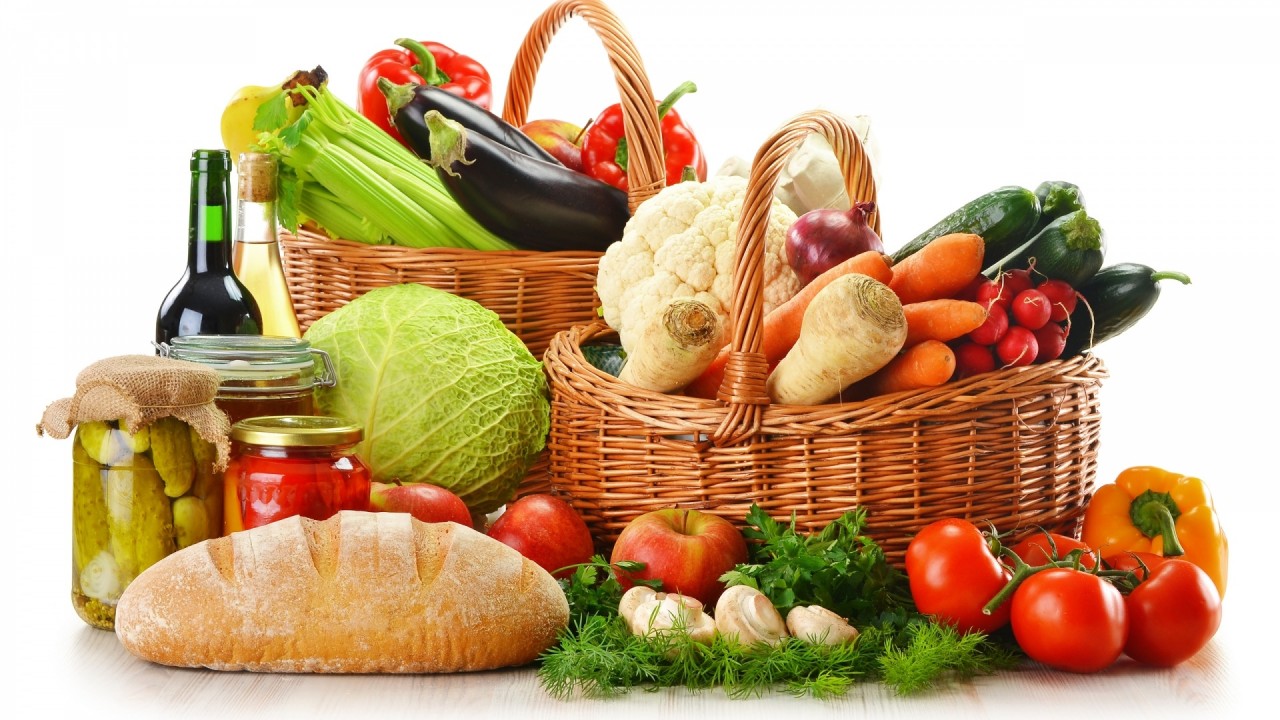
A diet for hypothyroidism of the thyroid gland can be either specially selected for the patient, for example, by a dietitian, or already prepared, like diet table No. 8 or the Mary Chaumont diet.
Diet table number 8
Diet table number 8 is an option for losing weight, getting rid of obesity and normalizing the body's metabolic processes. Its main principle is to minimize fats in the diet, especially of animal origin. Products for the dietary table are prepared by boiling, baking, steaming. Excluded from the menu:
- fat meat;
- sour cream;
- mayonnaise;
- sausages and smoked meats.
The list of products includes:
- white chicken fillet;
- cereals;
- vegetables;
- unsweetened fruits.
Meals 5 times a day, portions should be sufficient for saturation, but it is necessary to control the process and prevent overeating. Proper nutrition facilitates and helps eliminate unpleasant symptoms diseases. Diet No. 8 helps to reduce body weight by 2-3 kg per month, which is the optimal indicator of weight loss when the lost kilograms do not return back
Diet Mary Chaumont
Mary Chaumont, an American writer who was diagnosed with hypothyroidism, studied a huge amount of information on this topic, and made her own diet. She is categorically against dietary calorie restrictions, as this ultimately leads to even more weight gain due to the characteristics of physiological processes.
Caloric content according to Mary Chaumont is calculated as follows: multiply the patient's body weight in kilograms by 25 and subtract 200 kilocalories. That is, a person with a weight of 90 kilograms should consume 2050 kcal every day. That's enough. The secret is that you need to eat 6 times a day, but little by little.
While eating, metabolic processes are “launched”, which, as we already know, is slowed down with hypothyroidism. Therefore, this approach to nutrition is justified and gives good results. This is an excellent diet for hypothyroidism, contributing to weight loss. The food should contain proteins and vegetable fiber, the amount of fat should be strictly limited.
Menu example
Nutrition for hypothyroidism, even in the presence of strict restrictions, can be quite varied and tasty.
- for breakfast, you can choose something from this list: steamed scrambled eggs, vegetable stew, a small portion of liquid porridge with low-fat milk, coleslaw, vegetable puree;
- second breakfast: fruit and vegetable salad, berry jelly, jelly, low-fat cottage cheese with berries;
- lunch: vegetable soup, low-fat fish soup, steam cutlets or chicken fillet soufflé, stewed vegetables;
- afternoon snack: baked apple, low-fat yogurt, berry-fruit mousse;
- dinner: vegetable salad or mashed potatoes, baked lean fish, baked vegetables, pumpkin porridge.
Quite often, a certain disease requires special approaches to eating, and a decrease in organ function in the form of a “butterfly” is no exception.
This article is about diet and nutrition for hypothyroidism in women and men, what foods can and cannot be eaten with reduced thyroid function, an approximate menu for each day of the week.
We are confident that you will undoubtedly find comprehensive answers to questions about food intake and food choices in the article.
What should be the diet and nutrition for hypothyroidism?
Since there can be many reasons for low organ function, the approach to diet therapy should be different. Let's try to talk about all the cases and what to eat in this or that case, but in more detail we will dwell on nutrition and diet for autoimmune thyroiditis (Hashimoto's thyroiditis).
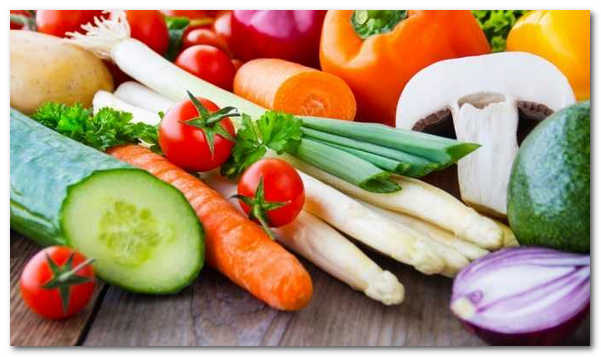
We would like to point out that dietary recommendations are in no way a substitute for the prescribed treatment. Diet therapy is a good helper, but it cannot replace medication if they have been prescribed, especially at the very beginning of the transition to a new diet. In some cases, it may be necessary to reduce the doses of drugs or try to cancel them, but these issues should be agreed with the attending physician.
So, for starters, let's recall the main reasons that can cause hypothyroidism in both women and men.
- Autoimmune thyroiditis (Hashimoto's thyroiditis)
- Mineral deficiency (selenium, zinc, iodine)
- Depleted Adrenal Syndrome
- Postoperative hypothyroidism or hypothyroidism after radioactive iodine
- Hypothyroid phase of subacute thyroiditis
- postpartum hypothyroidism
- Congenital hypothyroidism due to anatomical abnormalities in the development of the thyroid gland
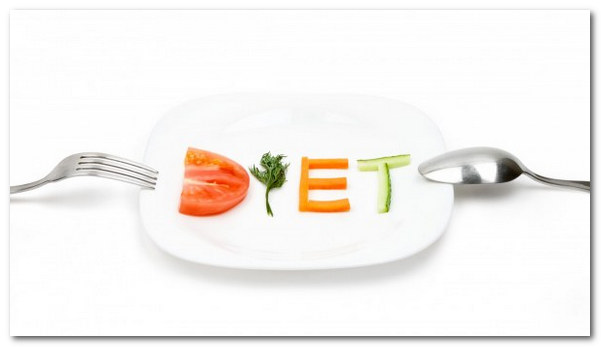
For the last 4 types of hypothyroidism, nutrition does not differ from that of a healthy person. It implies sufficient intake of protein and healthy fats, moderate consumption of carbohydrates, a complete rejection of refined prepared foods (sweets, pastries, ready-made desserts, convenience foods, canned foods, snacks, etc.).
Let us examine in more detail the first three causes and diet therapy for them, and we will dwell on nutrition in AIT in a particularly similar way.
Nutrition for hypothyroidism due to adrenal wasting syndrome
Not many people know that the work of the adrenal glands and the thyroid gland has a very close relationship. Violation of one organ entails a decrease in the function of another. Quite often, with tired adrenal syndrome, the conversion of thyroxine (T4) to the more active triiodothyronine (T3) is reduced.
As a result, the so-called euthyroid pathology syndrome (SEP) occurs, when the levels of TSH and T4 are normal, and the level of T3 is reduced due to impaired conversion in the periphery. At the same time, there is no obvious disease of the thyroid gland, but there are pronounced symptoms of hypothyroidism and impaired well-being.
Unfortunately, in official medicine, the syndrome of exhausted adrenal glands is unrecognized and therefore a lot of patients are overlooked. In this article, we will not talk about this syndrome, it is better to devote a separate detailed article to it. Let's just say that this condition is, as it were, a mild manifestation of adrenal insufficiency, which is directly related to stress, chronic infection, serious illnesses and injuries. At the same time, the synthesis and rhythm of secretion of hormones of the adrenal cortex is disturbed, which invariably affects the functioning of the thyroid gland and its hormones.
So, what diet should be in this condition? Let's describe the basic principles.
- Exclusion of coffee and sweets
- Healthy fats at every meal
- Enough animal protein for breakfast and lunch
- Carbohydrates preferably in the afternoon
- Snacks are not provided, but not prohibited
- Eating foods high in resistant starch
The physiology of the work of the adrenal glands is such that the level of steroid hormones is maximum in the morning until noon, and in the afternoon the concentration begins to decrease and by the beginning of the night it is minimal. Cortisol levels are inversely related to insulin levels, which increase in the late afternoon.
In patients with depleted adrenal glands, not only the concentration of cortisol is reduced, but also the circadian rhythm of secretion is disturbed. Some may have a monotonous rhythm, some have an increase in cortisol secretion in the evening. The special distribution of nutrients throughout the day helps to restore the physiological rhythm.
That is why in the morning a minimum of carbohydrates is recommended, except for fresh vegetables, fiber content, but a good portion of food containing proteins and fats. Eggs are ideal for this. Preference should be given to animal proteins.

In the evening, insulin activity rises, and therefore carbohydrates can be allowed to prevent a drop in glucose levels, which leads to adrenal activation at the wrong time. However, carbohydrates should come mostly from vegetables soaked in legumes. Brown and wild rice, buckwheat, quinoa, amaranth, as well as potatoes boiled in their skins and chilled are allowed. Fruits with low glycemic index(berries, grapefruit, lemon, apple, plum).
Healthy fats are considered: olive, any fat from a “clean” animal, avocado oil, coconut oil. Allowed the use of nuts and seeds (almonds, macadamia, hazelnuts, cashews, cedar, walnuts, pistachios, flax seeds, pumpkin, sunflower, chia).
Harmful fats and oils are: all trans fats, hydrogenated oils, oils containing a large amount of OMEGA 6 (sunflower, rapeseed, corn).
Diet with a deficiency of minerals (selenium, zinc, iodine)
The title itself implies a diet rich in these trace elements, which are directly involved in the functioning of the thyroid gland and the action of hormones in the periphery. Currently, all these minerals are scarce in almost all regions of Russia.
The highest concentration of iodine is seaweed, seaweed and seafood (fish and their caviar, shellfish, squid, crabs, shrimp and others). Among the "land" iodine, there are many in feijoa and persimmon, which are often recommended for hypothyroidism. In addition, it is recommended to use iodized salt, sea salt or pink Himalayan salt to replenish iodine.
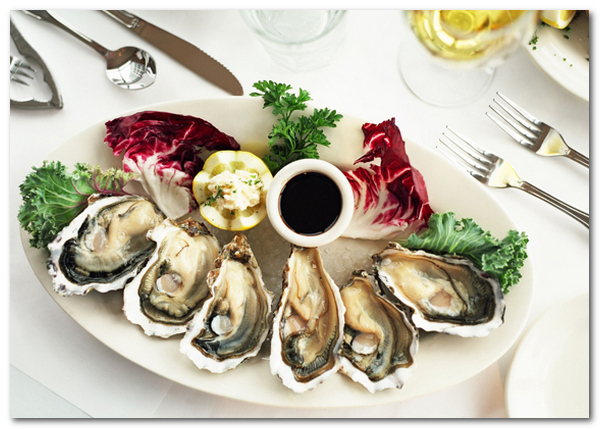
Selenium in large quantities can only be obtained from plants, but since our soils have become poor in this valuable mineral, plants do not contain it in sufficient quantities. Although you can try to get it from food. The brazil nut is considered the champion among such products. They say that 3-4 nuts per day are enough to meet the daily requirement for selenium. There is also a lot of selenium in ordinary garlic if it was grown using selenium-containing fertilizers.
Another important trace element - zinc - can be found, as well as iodine, in seafood, as well as offal (liver, tongue, kidneys, heart, tongue) and in various nuts (pine, pecan, Brazilian).
However, it is often not possible to fully compensate for the need for minerals, since not physiological preventive doses are needed to eliminate hypothyroidism, but therapeutic doses, especially for selenium and zinc, so you can additionally take concentrated supplements of selenium and zinc in chelate form.
Diet for autoimmune thyroiditis
Analysis of nutrition in Hashimoto's thyroiditis is of particular importance, since a large proportion of all cases of hypothyroidism are due to an autoimmune process in the thyroid gland. If you don't already know, then AIT is a disease with an undulating course. Periods of immune aggression are replaced by relative calm. During a reduced attack on the gland, its function is better, so any measures must be taken to prevent a new surge in the autoimmune reaction.
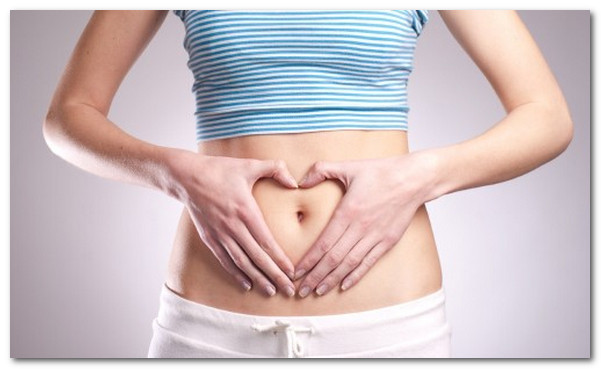
In this case, compliance is very helpful special diet, which eliminates problems with the intestines - the main trigger of Hashimoto's thyroiditis.
Here are the basic principles of nutrition for autoimmune thyroiditis.
- Exclusion from the diet of foods containing gluten.
- Exclude FODMAP products.
- Exclusion of dairy products (optional).
- Adequate intake of animal protein and healthy fats, especially butter and coconut oil.
- Consumption of foods rich in selenium and zinc or in supplements.
- Increase intake of Omega 3 fatty acids.
- Exclusion of refined sugars.
- Exclusion of vegetable oils rich in Omega 6 fatty acids.
The question of products containing goitrogens, i.e., goitrogenic substances, is constantly being discussed. These include plants from the cruciferous family: all cabbage, turnip, radish, radish, rapeseed, horseradish and mustard, and spinach, millet, peaches, peanuts, sweet potatoes, strawberries and even pears are also considered goitrogenic.
However, there were no reliable facts in favor of the exclusion of these products from the diet due to goitrogenic effects. At the same time, many of these products are also of great benefit. Therefore, we believe that eating these foods in small amounts as a dietary variety will not harm thyroid health, unless, of course, there is an allergic reaction to one.
Gluten is the biggest enemy of the gut. It is paid attention only when there is a serious disease - celiac disease. But studies have shown that high gluten sensitivity is present in a large number of people without visible digestive disorders. Even the definition of markers of celiac disease does not give a clear answer. Therefore, every person with AIT is shown a gluten-free diet.
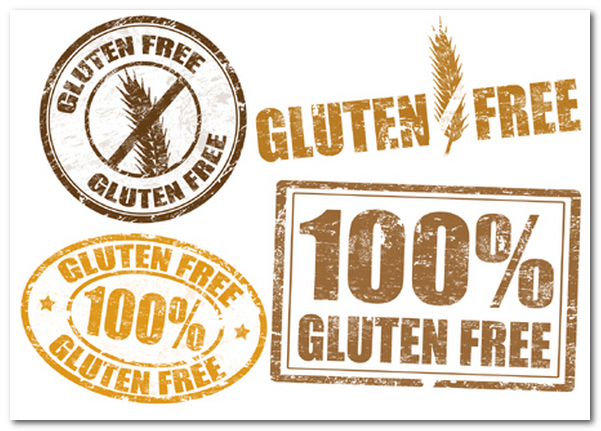
This substance causes a violation of parietal digestion and microinflammation in the intestinal wall, as a result of which the so-called “leaky” or “leaky” intestine syndrome develops. Large spaces are formed between epithelial cells through which large protein molecules, toxins, and bacteria enter the bloodstream. It's starting to get annoying immune system and, starting to fight with antigens, it begins to affect its own organs, in this case, the “thyroid gland”.
Gluten is found in wheat, rye, barley and oats. And also in finished products using flour or bran of these cereals. There are products where pure gluten powder is added as a binder. Therefore, we recommend reading product labels.
The importance of dairy products, and in particular casein protein, in maintaining AIT is disputed. If possible, it is better to refrain from using these products for a while, and then you can try to return, alternately checking the body's reaction to them.
Vegetable oils with Omega 6 support inflammation, while Omega 3, on the contrary, eliminates it. Therefore, you need to reduce the first and increase the second in the diet. There will also be a separate article about polyunsaturated fatty acids.
The thyroid gland does not like fast-digesting carbohydrates, this also applies to honey with hypothyroidism. So that needs to be excluded.
Your diet should include enough complete proteins and healthy fats. Which ones we talked about in the section on adrenal exhaustion syndrome. And the consumption of foods rich in selenium and zinc should always be a priority, or you can drink special supplements with chelated selenium and zinc.
Today you learned about nutrition for hypothyroidism from various reasons, what you can and cannot eat and why, a little about the diet. Click the social buttons networks, if you liked the article.
Sample menu for each day of the week with AIT
Monday
Breakfast: Omelette (2 eggs + cream), dill/parsley, cucumber, cheese slice, tea/cocoa, stevia sweetener.
Lunch: Borscht, 150 g of meat, sour cream, fresh carrot salad with olive oil, 10-15 g of dark chocolate, tea.
Snack: 10-15 nuts (almonds, hazelnuts, cashews).
Dinner: Grilled chicken, baked pumpkin, greens, apple, tea with a slice of dark chocolate.
Tuesday
Breakfast: Cottage cheese with sour cream, cinnamon and apple, tea.
Lunch: Turkey in sour cream, baked zucchini rings, fresh cucumbers and tomatoes, greens. For dessert, low-carb Coconut Cookies
Afternoon snack: Boiled shrimp.
Dinner: Beef stroganoff with stewed cabbage and egg, greens, tangerine, cheese slice with butter and tea (stevia sweetener optional).
Wednesday
Breakfast: Scrambled eggs with bacon and spices, cheese with butter, natural cocoa.
Lunch: Vegetable soup with beef, sauerkraut salad, 100 g sour cream, tea with a slice of dark chocolate.
Snack: Apple, cheese with butter, tea.
Dinner: Sea fish with wild rice, greens, fresh cabbage salad. Tea with low carb blueberry muffins.
Thursday
Breakfast: You can afford to eat what's left from Wednesday's dinner.
Lunch: Homemade chicken broth with boiled egg and green onions, 150-200 g of meat, salad of freshly grated carrots with olive oil, tea at will.
Afternoon snack: Low-carb muffin, tea, a few nuts.
Dinner: Chicken liver and hearts in sour cream, stewed or steamed vegetables (broccoli, green beans, cauliflower), fresh vegetable salad with sour cream or olive oil.
Friday
Breakfast: Cocoa with coconut and butter, cheese.
Lunch: You can afford to eat what's left from Thursday's dinner.
Afternoon snack: Whole ripe avocado with salt and pepper.
Dinner: Stewed veal with mushrooms, grilled or baked vegetables, greens, canned olives or black olives. Tea with a slice of dark chocolate.
Saturday
Breakfast: Fried eggs with bacon, cheese with butter, tea
Lunch: Lentil soup (if there is tolerance), fresh vegetable salad, 100 g sour cream, an apple.
Snack: Cottage cheese with sour cream and berries.
Dinner: Lamb shish kebab with grilled vegetables, a lot of greens, spicy carrots “Cha”, a glass of dry red wine.
Sunday
Breakfast: Omelette (eggs + cream + mozzarella), apple
Lunch: Veal steak with vegetables, salad of greens and fresh vegetables, tea.
Afternoon snack: Nuts or seeds.
Dinner: Salted herring with boiled and chilled jacket potatoes, greens, Chinese cabbage. Tea with bitter chocolate.
Today you learned about the principles of nutrition when different reasons hypothyroidism. In the next article, we will analyze the important question “How to lose weight with hypothyroidism?”. One diet is not enough...
Diet is not only a method of losing weight, but also a component of the complex treatment of many diseases. So, it is extremely necessary for the thyroid gland, because the pathology leads to a violation of the production of hormones, therefore, without proper nutrition, the patient's well-being worsens. How to build your diet?
What is the diet for hypothyroidism?
Thyroid disorders affect the entire bodyHypothyroidism is a group of syndromes that occur when the production of thyroid hormones is impaired. Organ damage leads to hormonal imbalance.
There are 4 forms of pathology:
- primary;
- secondary;
- tertiary (central);
- tissue (peripheral).
The development of the primary form occurs in the presence of hereditary defects in hormone production, which leads to disruption of the thyroid gland. As a result, the level of hormones produced decreases. The secondary type occurs when there is a malfunction in the functioning of the pituitary gland, an organ that regulates the production of thyroid-stimulating hormones.
The tertiary form is formed when exposed to hormonal agents or when the hypothalamus is damaged. A decrease in the number of cells that affect the production of hormonal compounds also contributes to the onset of tertiary hypothyroidism. The tissue type is associated with the resistance of receptors to hormones, while the thyroid gland and other organs function normally.
According to the origin of the condition, congenital and acquired forms are distinguished:
- congenital hypothyroidism occurs during the embryonic development of the fetus under the influence of many factors, so the child is born immediately with pathology;
- the acquired form occurs during life under the influence of pathological factors, for example, after partial resection of the gland.
Synonyms of the disease: hypothyroidism, thyroid insufficiency, myxedema.
So what is the diet for? Hypothyroidism leads to disruption of metabolic processes. The patient suffers from increased fatigue and weakness, drowsiness and apathy occur.
The task of the patient is to help the thyroid gland by starting to restore it, and for this you need the right diet containing minerals, vitamins and other useful elements. With its help, get rid of the unpleasant manifestations of the disease: lethargy, swelling and irritability.
Weight loss is another patient goal. Mass gain is also caused by a violation of metabolic processes, so the right diet will not allow you to consume extra calories, carbohydrates and fats. The main thing is to take care of your diet and yourself.
Features of nutrition in case of illness
A variety of methods and techniques are used to organize food. Hypothyroidism is often used:
- Table number eight. During the diet, reduce the daily calorie intake. The patient consumes food for 1200-1800 kcal per day. Fats of animal origin are excluded from the diet, therefore they refuse sour cream, cheeses, butter and fatty meat. Eat proteins (kefir, white fish, lean poultry meat) and plant foods.
- Diet Mary Chamon. Endocrinologist M. Shamon insists on the position that a decrease in the daily calorie intake will lead to a greater slowdown in metabolic processes. Food is taken in small portions, and calories are calculated by the following formula: the patient's weight (in kg) is multiplied by 25, and 200 is subtracted from the result.
Compliance with any diet requires the implementation of such principles and rules as:
- fractional nutrition;
- product processing;
- food temperature;
- salt regime;
- balance of vitamins and nutrients;
- drinking regime.
Food is taken 5-6 times a day in small portions. Fractional nutrition has a beneficial effect on the patient's condition, since the gastrointestinal tract absorbs vitamins and useful minerals better, and also breaks down nutrients - proteins, fats and carbohydrates.
Food must be processed by baking, steaming and boiling. All products are crushed - this helps to reduce the load on the digestive organs. Fried foods are prohibited, since during frying fat breakdown products occur, and they negatively affect metabolic processes and blood vessels.
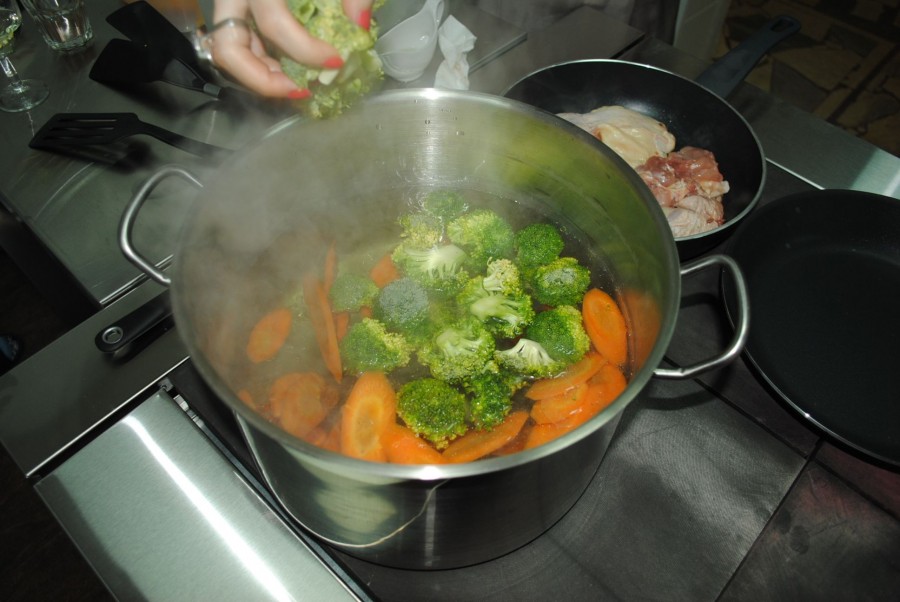 Boiling is one of the safest ways to process foods during a hypothyroidism diet.
Boiling is one of the safest ways to process foods during a hypothyroidism diet. Only warm food is allowed. Its temperature is 15–60 °C and not higher. Hot and cold foods should not be consumed, as they irritate the digestive organs. In addition, the body spends more resources on their digestion, and for the patient this is an additional burden.
Salt is important for the human body, but with hypothyroidism a restriction is introduced - no more than 5 g is allowed per day. This rule spares the stomach and does not lead to fluid retention. It is recommended to use iodized salt, as iodine is needed for the normal functioning of the thyroid gland.
Food - only enriched with vitamins and nutrients. The body needs vitamins - they stimulate metabolic processes, and some take part in the work of the thyroid gland. Ascorbic acid is useful, which has a beneficial effect on the walls of blood vessels, therefore preventing the development of edema. The inclusion of vegetable fiber in the diet normalizes intestinal motility.
Compliance with the drinking regimen is an important component of the diet. The amount of fluid consumed is limited to 1.5 liters per day. Indeed, with hypothyroidism, edema often appears, and they occur due to fluid retention in the body.
Alcohol is completely prohibited for patients with hypothyroidism. Ethyl irritates the digestive tract and leads to a slowdown in metabolic processes.
The daily norm is 2200–2400 kcal, if necessary, it is lowered to the previously mentioned 1200–1800 kcal. Also, the diet for hypothyroidism focuses on the amount of nutrients consumed:
- fats - 70–80 g;
- proteins - 80 g;
- carbohydrates - 350–400
The origin of nutrients also matters:
- sugar should be no more than 50 g of the total amount of carbohydrates per day;
- 35% of fats consumed are vegetable;
- 50-55% of the proteins consumed per day are of plant origin.
What is the duration of the diet? It depends on the patient's well-being, the presence of problems with body weight and the stage of development of hypothyroidism. Decide how long and what diet to follow, can only be done by a doctor after the diagnosis.
Allowed and prohibited products - table
| Approved Products | Prohibited Products |
|
|
Prohibited products in the photo
 It is not recommended to use pickles with hypothyroidism
It is not recommended to use pickles with hypothyroidism  Cakes are beautiful to look at, but their ingredients can kill the patient
Cakes are beautiful to look at, but their ingredients can kill the patient ![]() Jam is used in small quantities.
Jam is used in small quantities. 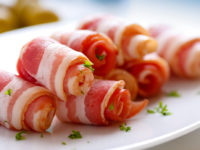 Salo is a high-calorie product, so it is excluded from the diet
Salo is a high-calorie product, so it is excluded from the diet
Menu for every day - table
| Day of the week | Monday | Tuesday | Wednesday | Thursday | Friday | Saturday (fasting day, use one of the named products) | Sunday |
|
Patient's diet (divided into 5-6 servings) |
|
|
|
|
|
|
|
Healthy Recipes
A diet for hypothyroidism does not mean that you have to limit yourself in everything. The menu is not characterized by scarcity, so you can choose the right dishes for yourself.
Baked chicken with vegetables
Perfect for an evening meal. You will need the following ingredients:
- chicken fillet - 0.5 kg;
- carrots - 3 pcs.;
- onions - 3 pcs.;
- 4 potatoes
- greens: a little dill, celery or parsley;
- vegetable oil - 3 tbsp. spoons;
- on the grated cheese- 100 g.
Cooking method:
- The chicken fillet is separated from the skin and cut into small pieces. Grind carrots and potatoes in advance.
- Put potatoes on a baking sheet, mixing it with carrots, and put meat on top.
- Pour 1 glass of water into a small saucepan, add 1 tsp. a spoonful of salt and pour oil into it.
- This mixture is poured over meat with vegetables and sent to a preheated oven for 30-40 minutes.
- At the end of cooking, grated cheese is mixed with herbs and spread on a casserole - melted cheese will cover the casserole with a delicious crust. Bay leaf;
- fresh herbs: parsley, dill.
- Potatoes, olives and onions are placed in boiling water, brought to readiness.
- Beets, parsley root and carrots are boiled separately, after chopping them.
- Spread onions, parsley, beets and carrots in borscht.
- Salt to your liking, put a bay leaf.
- Sprinkle with fresh herbs before serving.
Cooking borscht is very easy:
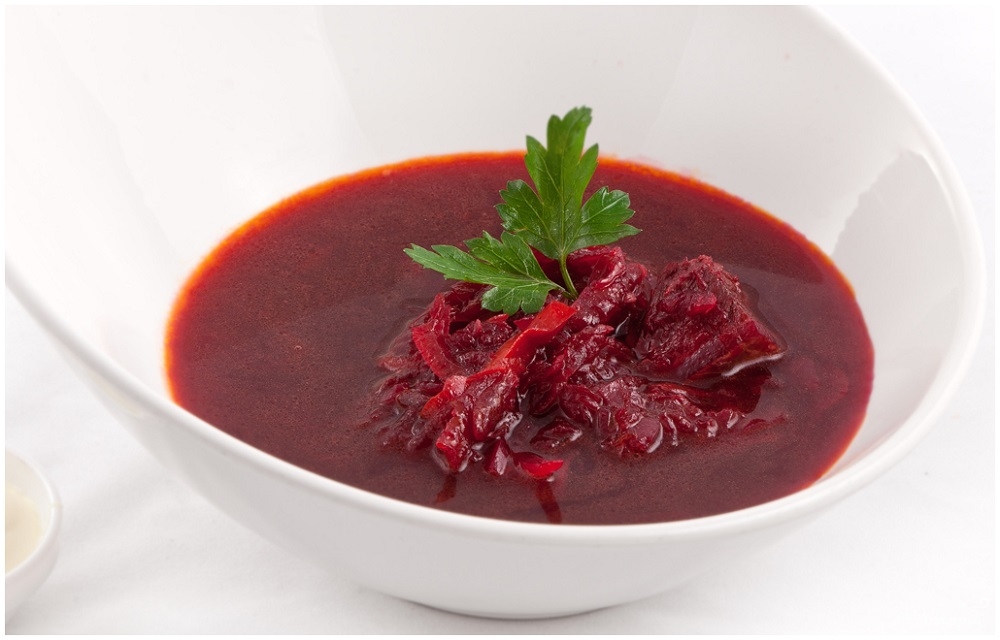 Vegetarian borscht is good as a first course
Vegetarian borscht is good as a first course Diet result
After completing the diet, the patient may find the following results.







